Inje Icefish Festival Have you heard about Inje? Inje is selected as one of 50 must see attractions in Korea by CNN travel. For a long time, Inje has known for 8 beautiful sightseeing and also famous for white-water rafting now days. Inje Ice fish Festival is regarded as the most well-known festivals in Gangwon province. This festival will be held in Soyangho lake in Inje. Visitors can experience ice fishing or other exciting programs such as Ice fish food experience, Ice-soccer, Trekking course, catch fishes in Soyangang river, and climbing an ice wall. Would you like to do something fun in Korea during winter season? Visit Inje Ice fish festival and experience exciting winter!!
| Schedules |
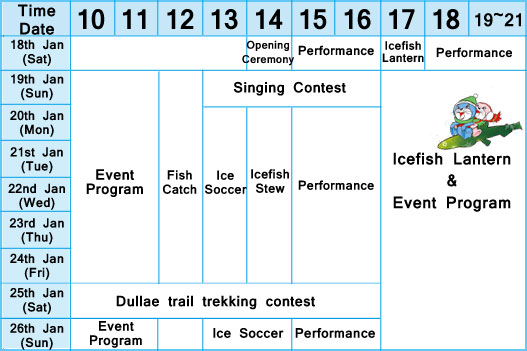
○ Period : 18th Jan 2014 ~ 26th Jan 2014
○ Address: Nam-myeon, Inje-gun, Gangwon-do
○ Tel : +82 2 1330(Korean, English, Japanese, Chinese)
▶Icefish Lantern lighting ceremony(18th Jan 2014, 17:00~17:30)◀At the opening ceremony of festival, ice fish lanterns are brightened with various colors. See and enjoy beautiful Inje with colorful ice fish lanterns..
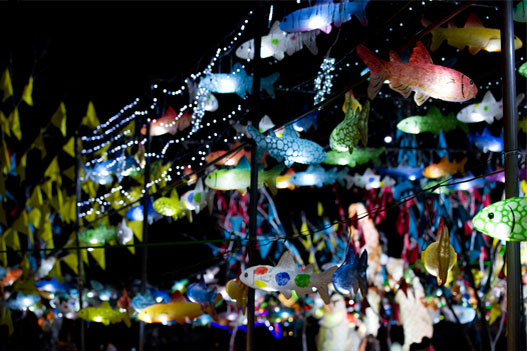
(Photo : Inje Icefish Festival official website)
▶Icefish fishing(18th Jan 2014~28th Jan 2014)◀
Do challenge who will catch ice fish most! It costs KRW5,000 per one hole.

(Photo : Inje Icefish Festival official website)
▶Snow-sledding(18th Jan 2014~26th Jan 2014)◀
Make a good memory with family, friends, and lovers. It costs KRW5,000 for renting one sleigh.
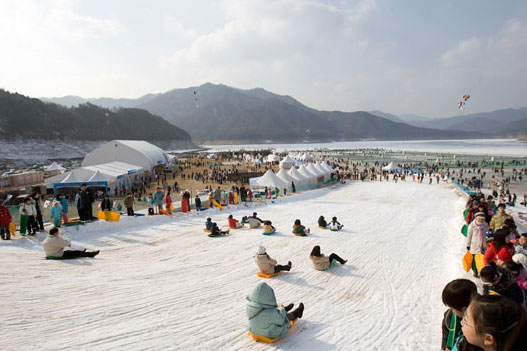
(Photo : Inje Icefish Festival official website)
▶Climbing Ice-wall(18th Jan 2014~26th Jan 2014)◀
Challenge ice-wall climbing in a beautiful nature. It costs KRW5,000 per person.
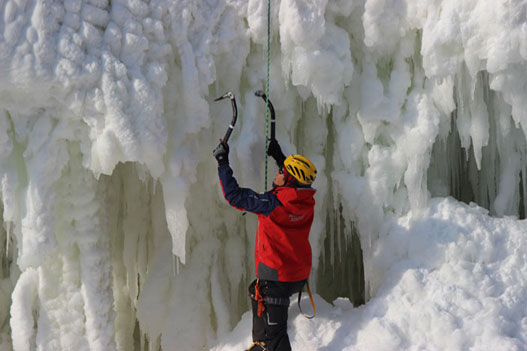
(Photo : Inje Icefish Festival official website)
▶Icefish Food Experience(18th Jan 2014~26th Jan 2014)◀
Visitors can experience various cuisine made of ice fish.

(Photo : Inje Icefish Festival official website)
| Directions |
▶By public transportation◀
Take a express bus heading to Inje from Dong-Seoul bus terminal(Gangbyeon Subway Station, Line#2). It takes 1hour 30mins to get to Inje bus terminal. It costs KRW13,000 for adult and KRW6,500 for child. From Inje Terminal, take a taxi or catch a shuttle bus heading to festival venue(10mins)
▶By private car◀
We, PACKAGEKOREA, arrange transportation and admission tickets. Please feel free to contact me if you need detail information!(jsy@packagekorea.com)
Inje Tour Guide
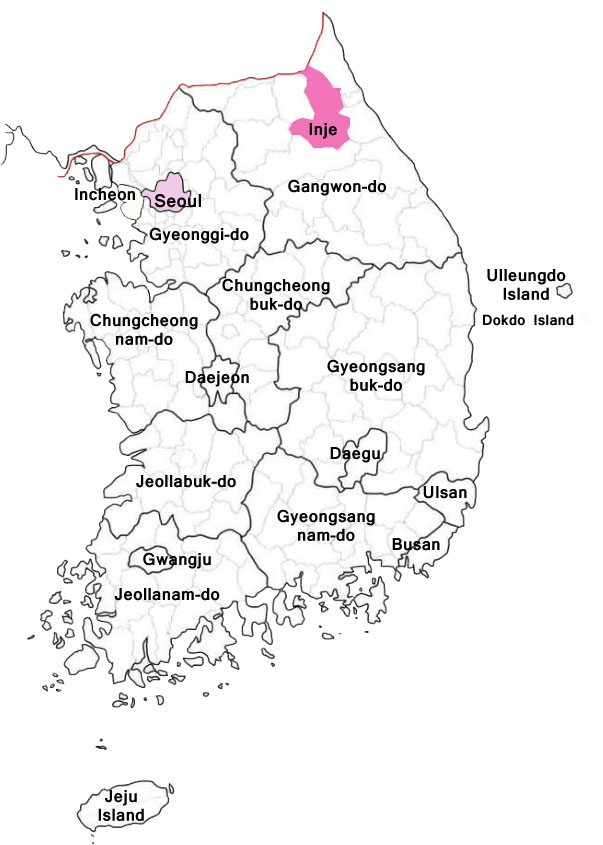
| Sightseeing : 8 Beauties of Inje |
▶ Daecheongbong Peak – At 1,708 meters high, Daecheongbong is the highest peak in Seoraksan National Park and the third highest peak in Korea following Hallasan Mountain (1,950 meters) and Jirisan Mountain (1,915 meters). It marks the point where Nae-Serok (inner Serok) meets Oe-Serok (outer Serok). Due to irregular climate and low temperatures, it is home to various stunted high mountain plants and about 50 rare plants, as well as a variety of wild birds. From Daecheongbong Peak you can view the fascinating landscape of Seoraksan Mountain in all four directions.
▶ Sibiseonnyeotang Valley – Sibiseonnyeotang Valley (Valley of Twelve Angels’ Bath) is located at the base Mt. Seoraksan. It is also referred to as Tangsugol or Tangsudong Valley. The valley got its name from a myth that angels once came down to bathe in its flowing rivers. However, there are only 8 baths.
Due to fluvial erosion there is a steep hole in this valley and many baths and waterfalls of various shapes are stretched over an 8km distance. Pass Ungbong Waterfall and the first bath, and Dok-tang appears. Then walk past Buk-tang, Rainbow-tang, Peach-tang, and the path will end with the last bath, Yong-tang.
Of these baths, the 7th bath is called Peach-tang, named after the traditional shape of the bath. The deeply delved rock behind the back of the waterfall is more beautiful than the bath under the waterfall. Past the Peach-tang, there is another clean, steep bath. From there, a 5-minute walk to the right will lead you to another waterfall and a pool. The water from Daeseungryeong and Mt.Ansan is connected to Namgyo-ri, Buk-myeon. This is an 8-km valley, which takes approximately two hours from the baths to Namgyo-ri. There are iron bridges over the baths for visitors to cross.
▶ Naerincheon Valley – Naerincheon River, the only river that flows north in Korea, crosses Hongcheon and Inje. The name “Naerin” (‘cheon’ means small river in Korean) is a compound word: ‘Nae’ is from Hongcheon-gun’s “Nae”-myeon area and ‘Rin’ from Inje-gun’s “rin”-myeon area. Above the river are many fantastic rocks and stones, and the water that runs along the valley is so pure that you can clearly see the sand and pebbles at the bottom. Naerincheon Gyegok Valley starts near Mt. Odaesan Valley and Hapganggyo Bridge and continues on for about 57 km. Since the range is so long, it is hard to pinpoint Naerincheon. Usually, when people say Naerincheon, they mean the downstream of Naerincheon. The upper stream of Naerincheon is again divided into Misan Valley or Moraeso Valley. Few people go there because it is hard to reach. On the upper stream of Bangtaecheon, which joins together with Naerincheon, is Jindong Valley, and to the north of Naerincheon is Mt. Jumbongsan, Mt. Bangtaesan, Bangdong Springs, and Mt. Bangtaesan Recreational Forest. Also, there are Hwangso and Seori Resorts in the mid-section of Naerincheon, and Piasi Valley downstream. Piasi is the area around Gosa-ri, Inje-eup. Piasigang River is the water stream between Hyeon-ri and Soyangho Lake. These are the most popular places. Around the water stream of Naerincheon, there are many mountains and branch streams. Wide woods and rocks are here, and are very attractive to families that visit here to play water sports, fishing and camping.
▶ Baekdamsa Temple – Located on Naeseorak, Baekdamsa Temple was built by Ja Jang (590~658) during the reign of Queen Jin-Deok (647-654), 28th ruler of the Silla Dynasty. In the beginning, a temple called Hangyesa was built in Hangye-ri which was in the vicinity to Jangsudae. This temple was completely demolished by several fire accidents including one in the year 690, during the reign of King Sinmun. It changed its locations to several other sites and was renamed Youngchuisa, Simsa, Baekdamsa, and Simwonsa Temple.
A stone bridge called Susimgyo is built across Baekdam Gyegok Valley to the front of Baekdamsa Temple. Wooden Amityus Buddha Statue, designated as National Treasure No.1182, is preserved here at Baekdamsa Temple. This Buddhist statue was made in 1748 during the reign of Yeongjo (reign 1724~1776) and is known as the most outstanding statue in the early 18th century. Currently remaining structures include Geukrakbojeon, Sanryeonggak, Hwaeomsil, Beophwasil, Jeongmun, and Yosachae. In the courtyard, there is a three-story stone temple remaining to this date. As for temples, Bongjeongam, Oseam, and Wonmyeongam remain till today.
▶ Daeseung Falls – Daeseung Falls was known as a major recreation site of King Gyeong-Sun (reign 927~935), the last king of Silla Dynasty (BC 57~AD 935). The size is twice as large as those of Guryong Falls of Mt. Geumgangsan or Bakyeon Falls of Gaeseong. It is located in the Naeseorak area of the Mt.Seoraksan. Across from Daeseung Falls is a large rock, where in Chinese characters “Gucheoneunha” is carved. The stream of the waterfall is 88m long. Pass to the left of Jangsudae ticket booth, go past Sajung Falls and climb up a steep and rocky path, and you will reach an observatory area where you can view the scenery of Daeseung Falls. Along the path leading to the observatory area is an iron ladder. Walk on the right walkway to Daseungryeong for 5 minutes and you will meet a narrow path that leads right up to the waterfall. This pathway attracts many visitors because of its beautiful surroundings and water streams.
▶ Bangdong Mineral Spring – Bangdong Mineral Spring is located in Bangdong-ri in Girin-myeon. It is so renowned that it has been designated as one of the Great Mineral Springs of Korea. The water has a high content of carbon that makes it sparkle, and it tastes like Korean 7-up when sugar is added. In addition to carbon, the water also contains iron, manganese, and fluorine, making it effective in curing gastric problems and helping digestion.
According to legend, there lived a simmani (ginseng digger) 300 years ago, one day the man dug a 60-year old wild ginseng in Bangdong-ri. Called yukgumandal, the ginseng was known as a great medicine of mystery. From the spot where the ginseng was dug came a mineral spring, which became today’s Bangdong Mineral Spring. The mineral spring has continued to attract people since the first day the ginseng was found and people who have drunk its water are said to have experienced various beneficial effects.
| What to Eat : Bingeo(Icefish) cuisine |
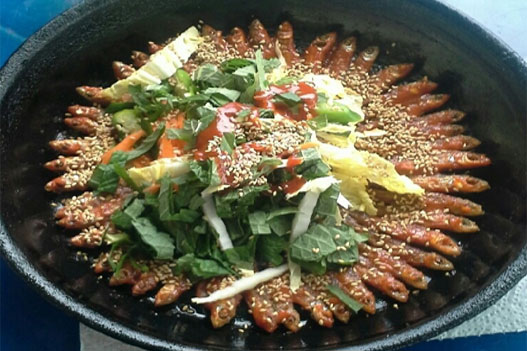
Bingeo(Ice fish) is one kind of external blue colored fish. Like other blue colored fish, ice fish is rich for protein, essential amino acid, and calcium so it helps preventing born disease such as osteoporosis, rickets. High-protein, low-calories ice fish also helps diet.


